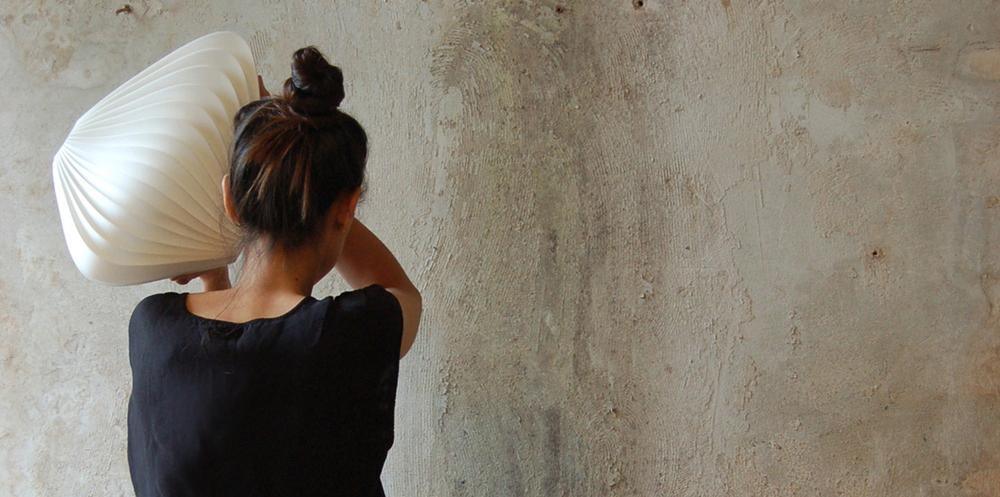There’s a room in Minneapolis, Minnesota so quiet that, should anyone sit inside it long enough, they’ll begin to hallucinate and beg to be set free from the horror.
Lined with fiberglass acoustic wedges three feet thick, surrounded by insulated steel and another foot of concrete, the design of the Orfield Laboratory Anechoic Chamber allows it to absorb 99.99 percent of the sound within. It’s rated at -9.4 dBA, well below the 0 dBA threshold at which the human ear can detect a sound.
While no architect wants their building to cause people to hallucinate, acoustic design is a critical factor in how comfortable a given interior space is to the people who live or work there. The reduction of noise by sound absorption has become crucial to architects, and acoustic design examines the peculiarities of the functions and spaces in a building, and it’s spurred researchers and architects to examine a variety of customized solutions to control ‘noise.’
 Foteini Setaki, the 3D printing expert at DUS Architects in Amsterdam, is considering the problem from a novel angle by using 3D design and objects to take on the issue. DUS Architects is also the firm responsible for the 3D printed “Canal House” project.
Foteini Setaki, the 3D printing expert at DUS Architects in Amsterdam, is considering the problem from a novel angle by using 3D design and objects to take on the issue. DUS Architects is also the firm responsible for the 3D printed “Canal House” project.
According to Setaki, current sound absorption devices are limited in their effectiveness as they must be tailored to the specific acoustic requirements of a given space. In the main, it comes down to geometry, materials, and fabrication techniques.
Setaki’s investigations into highly customized sound absorbers are based on a principle called passive destructive interference, or PDI. It’s the intimate relationship between geometry and acoustic performance that makes PDI absorbers work, and she uses advanced additive manufacturing techniques to build unique, freeform geometries to test and understand the acoustics underlying the performance of various materials and shapes.
 Her work for Studio Phi operates “at the intersection of architecture, building technology, and industrial design,” and technological advances in design tools and fabrication techniques are at the center of the project. She says the idea is that designers should be capable of “scripting environments that enhance sensorial experience,” and 3D printing makes it happen.
Her work for Studio Phi operates “at the intersection of architecture, building technology, and industrial design,” and technological advances in design tools and fabrication techniques are at the center of the project. She says the idea is that designers should be capable of “scripting environments that enhance sensorial experience,” and 3D printing makes it happen.
“The ultimate goal is to improve the acoustic quality of the built environment by developing innovative acoustic devices of high performance,” Setaki says. “This project focuses mostly in sound absorption, which is a technique broadly utilized for tailoring sound. The specific sound absorbers are designed to be applied in enclosed spaces, such as auditoriums, entrance halls, open offices and classrooms.”
While the project is mostly dedicated to ongoing research, the prototypes Setaki and her team create are functional. They’re used for physical tests and also as demonstration pieces.
In practice, the research works like this: 3D printed parts are initially tested in what’s known as an ‘impedance tube,’ where the sound absorbing properties of various samples are measured. A library of these 3D printed materials are checked for their sound absorbing capabilities and then prototypes are built from the data.
Setaki says sound is “an essential performance ingredient of space” that deeply affects our conscious — or unconscious — perception.
“Good acoustics contribute to healthier and safer environments,” she says. “The negative impact of poor soundscapes remains frequently unconsidered. Besides raising awareness for the sonic environment, this project envisions causing a shift in the manner soundscapes are conceived and in minimizing the unwanted effects of noise. Empowered by digital design and 3D printing, this cross-disciplinary project envisions educating our ears and introducing an acoustically better future.”
The designer says the project begins with the design — at the micro-scale — of 3D printed sound absorbing elements which explore three sound absorbing principles and five materials which can be optimized according to acoustic performance criteria.
“The knowledge gained from the physical tests is also implemented in the design of bigger prototypes,” Setaki says. “The 400.2K Collection is the second generation of 3D printed sound absorbers, tuned for wide frequency ranges. Formed by sound absorbing principles, the collection consists of customizable, one-material structures which tailor sound with performative geometries.”
And the results won’t make you crazy if you sit in a room that features them for more than half an hour.
According to Setaki, the work is funded in part by Creative Industries NL, Materialise, and Peutz.
What impact do you think 3D printing will ultimately have on architecture? Let us know in the 3D Printing Will Change What You Hear forum thread on 3DPB.com.

Subscribe to Our Email Newsletter
Stay up-to-date on all the latest news from the 3D printing industry and receive information and offers from third party vendors.
You May Also Like
3D Printing Financials: Fathom Struggles in Financial Quicksand During Critical Transition
Facing a year of key transitions and financial pressures, Fathom (Nasdaq: FTHM) has filed its annual report for 2023 with the U.S. Securities and Exchange Commission (SEC). The document outlines...
Latest Earnings Overview for Australian 3D Printing Firms Titomic and AML3D
Australian 3D printing manufacturing firms Titomic (ASX: TTT) and AML3D (ASX: AL3) reported their financial results for the period from July to December 2023, marking the first half of their...
3D Printing Webinar and Event Roundup: April 7, 2024
Webinars and events in the 3D printing industry are picking back up this week! Sea-Air-Space is coming to Maryland, and SAE International is sponsoring a 3D Systems webinar about 3D...
3D Printing Financials: Unpacking Farsoon and BLT’s 2023 Performance
In the Chinese 3D printing industry, two companies, Farsoon (SHA: 688433) and Bright Laser Technologies, or BLT (SHA: 688333), have recently unveiled their full-year earnings for 2023. Farsoon reported increases...
































